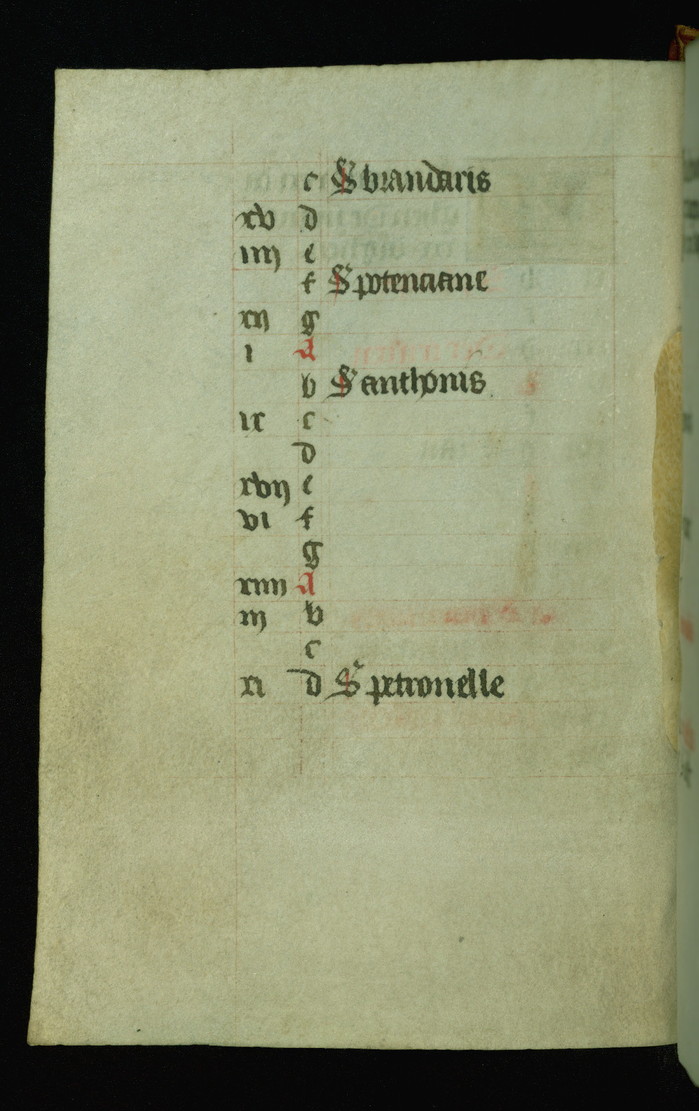A quick summary of several Books of Hours added from my most recent trip to the Morgan Library in New York.
- M.141 - A late 14th C Parisian book, with a simple red/black complete calendar. There are errors in the listings, but no more than the usual number. The later months have multiple unidentified saints, including a saint “Olati” for Dec. 10 and Saint “Dani” on Dec. 5. (DB Id: 234)
- M.729 - The Hours of Yolande de Soissons, this is a Psalter/Hours, but has been added due to the unusually specific location, Amiens, and the rather precise date, 1280-1299, for such an early book. The Calendar has some specific-to-Amiens feasts, such as the Octave of St. Firminus, October 2. It’s triple graded as well, with blue for high importance and red for more medium-weight saints, though that is not a definite interpretation. (DB Id: 77)
- M.739 - This is a particularly old hours, 1204-1219, and from Moravia, which is a rare location. The calendar is damaged for the month of January, with the last 10 entries very difficult to read. There is also evidence of multiple generations of writing and rewriting, including additional saints and obituaries. Five entries for November were erased and rewritten, and it is unknown if these were changed. Of the saints from the original strata there are many unusual ones, such as St. Columba, along with the usual Pope Silvester, on December 31. Multiple saints are not yet identified. (DB Id: 175)
- M.1054 - A nice late 15th C book of hours from Tours, decorated, according to the catalogue by a “Distant follower of Jean Bourdichon”. The calender has a fantastic architectural border on the rectos, with the zodiac and the labors integrated into the frame. Interestingly the calendar is unevenly split, with about 20-22 entries on the recto and only a few on the versos. It is almost complete, but several months have a missing name for the last of the month. (DB Id: 228)
- S.9 - A Parisian book, illustrated by two associates of the Luçon master. The calendar is error-filled, both containing many saints on the wrong date as well as having many of the initials incorrectly filled in as ‘S’, such as “Sostre Dame” for Nostre Dame and “Ses Innocens” for Les Innocens. (DB Id: 226)
Note that with these additions, the total number of entries in the DB is 48910, 31951 of those have at least one saint.
After another 2 day visit to the Morgan Library, I am once again bulk-loading data. The first three books from this trip are:
- M.487 - An English MS from the 1490s, probably made for a small child as there are many more educational texts than usual. Saints are quite British, including David, Cedde, Richard and Cuthbert. Unusually St. Edward, King, on March 18 is in red. (DB Id: 233)
- M.116 - A French MS from Cambrai, made in the 1490s. It contains a fair selection of feasts unique to Cambrai, including Translation of St. Barbara on Feb 12, St. Waltrude on April 9 and St. Salvius (in red) on June 26th. It also contains both the feast, on August 11, and the Octave, on August 18 of St. Gaugericus of Cambrai. (DB Id: 229)
- M.1089 - An Italian MS, probably made in the Veneto around 1425-1450. The calendar is misbound, ff. 6-7 are first, then ff. 1-5 and 10-14, no folios are numbered 8-9. The calendar is sparsely populated, only 116 entries, and very red, more than 50% of the entries. There are a few entries that might indicate a Fransiscan influence and one unusual one, St. Daniel the Prophet listed on July 24, though his feast is July 21. This is unique, so far, in the corpus. (DB Id: 106)
Houghton Library MS Typ 51 is a tiny (see below with iPhone) Book of Hours from France, dated to 1552. Though the title page and some running titles are in French, all of the prayers and the Calendar are in Latin. The calendar is mostly complete, 340 feasts and a few zodiac entries, but has enough blanks that it isn't clear it was ever intended to be full. The saints are a mish-mash, many are weeks or even months off of the proper date. Interestingly, unlike many of the complete Parisian calendars, some, but not nearly all, of the saints have titles (Bishop, virgin, etc). Some of the unusual errors are: Abdon et sennem (Abdon and Sennen) on March 30, their feast is July 30; Scolastice (St. Scholastica) on April 10 instead of February 10; Cleti pape (Pope Cletus) on November 5th, October 12 is his closest feast. Besides these large errors there are numerous saints shifted by 2-4 days, some be as much as a week or 10 days within the same month. There are also many unidentified saints who might be shifted from elsewhere in the calendar. In total I count 29 errors, or almost 10% of the total entries, not counting unidentified saints who might be erroneous.
(DB Id: 224)
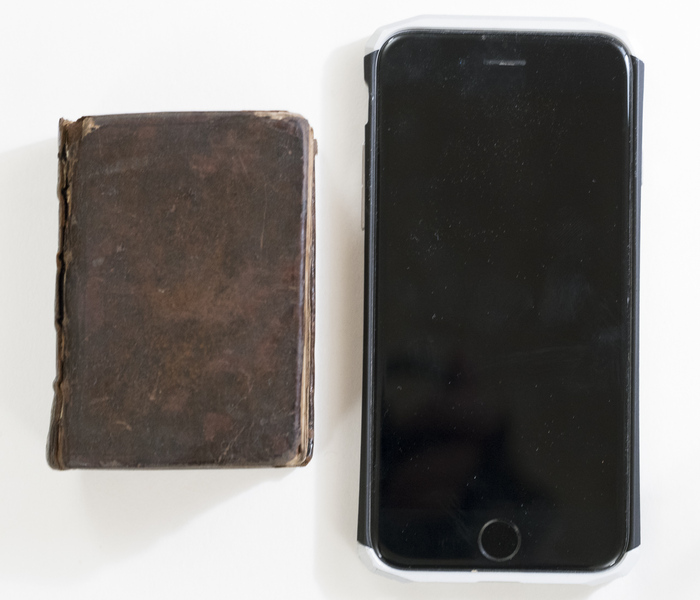
Trinity College, Cambridge, B.13.11 is a strange Hours from the late 15th century, created in Tournai, in Belgium. It is both liturgical and calendrical use of the city. The decoration is of a common style, with semi-illusionistic flowers over yellow borders around miniatures, but not of a very high quality.
The calendar, however, is highly detailed and unusual. It is approximately 2/3 full (241 dates populated), but with a total of 276 feasts, counting the 35 days with double names. Days are marked with the liturgical information (proper vs. common, # of lessons, duplex, triplex, etc) and double-feast days often have seperate information for each. A large number of pearled, equal-armed crosses have been, rather crudely, drawn in the margins. In the entries there are a number of very specific-to-Tournai feasts: both the feast (4152) and the octave (4153) of the dedication of Tournai Cathedral, along with St Martha (4157) on October 16 and both the feast of St. Piat (Piatus of Tournai, ᛭286 3195) in red and his octave (4156). One interesting scribal note is that the golden numerals, on the left side, are in often darker shade of red than the “red” saints.
(DB Id: 222)
From the Goethe University in Frankfurt comes a late 15th century Flemish book, Ms. germ. oct. 32, formerly catalogued as Ausst. 43.
The book is not entirely remarkable, but the calendar has an unusual pattern. There are several unidentified entries that could be about 7-9 days early, St. Patris (Patrick) listed on March 9 and celebrated on 17, St. Rufin (probably one of the 2 Sts. Rufina), listed on July 12 and July 19, and St. Juliene (Juliane), listed on June 7 and celebrated on June 16. Several other unidentified saints could suffer from the same transposition, though there is less evidence.
(DB Id: 220)
Back to the Morgan Library for M.493, the Morgan Black Hours, so called because they are written in silver and gold in on black-stained parchment. The bad news is that this treatment makes the illumination, particularly the colors, very fragile and prone to flake off. The good news is that means this is one of the few books at the Morgan that has been fully digitized. As is common, the style of the illumination seems to derive from the work of Willem Vrelent.
The calendar is sparse, with only 111 entries across the span of the year, nearly 1/2 of those (52) in gold for high importance. With that few entries it is harder to draw any conclusions from the calendar, but Bishop Donatiani (of Reims) (See October f.11r below) appears in gold, which seems unique to Flemish manuscripts.
(DB Id: 218)
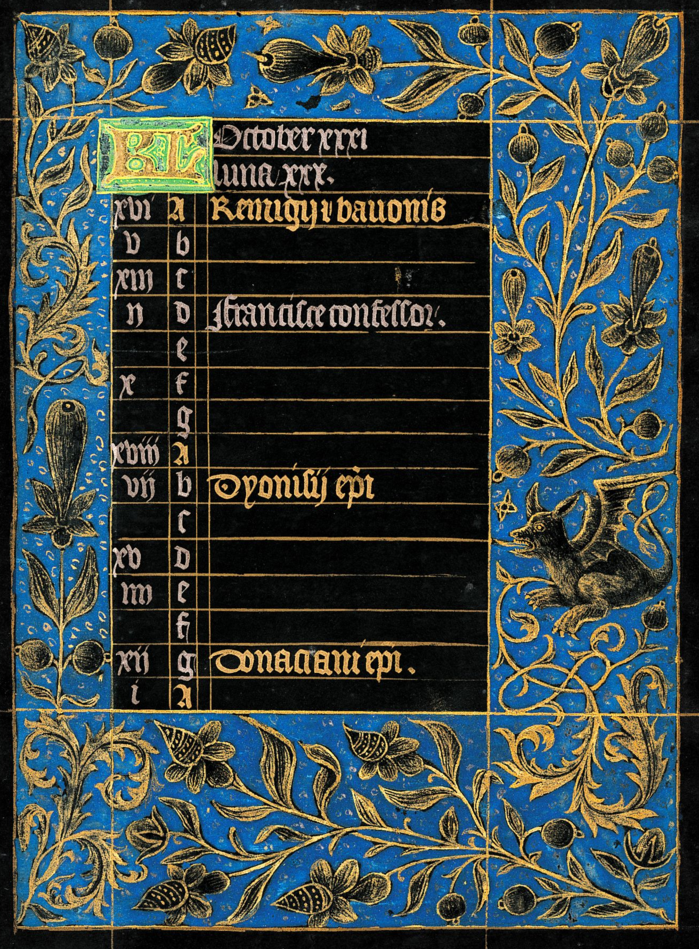
Walters Art Museum W.194 is another book from the Hainaut region of Belgium. It is attributed to between 2 and 4 illuminators, at least one working in the style of Simon Marmion (fl. 1449-1489). The calendar is pretty bare, with only 138 feasts, 41 of which are ranked red. There are not a large number of errors, 4 are identified, but it is unusual to see a high-importance feast like that of the Apostle Thomas on the wrong date.
(DB Id: 213)
Walters Art Museum W.193 is a French book of hours, with an unusual liturgical use of Cambrai, dated to roughly 1450-1460. There is evidence that the initial owner live in Mons, Hainaut (now part of Belgium). The calendar has some light decorations on the recto, an outer-border of acanthus leaves, and has 200 dates populated, though a higher-than-usual number of errors in the dating of saints. There’s also an unusual case, Saint Germain on August 8(see f.11r below) is unidentified, but ranked high. So far no “Germain” or similar name has been found for that date, but hopefully future work can identify this high-importance saint.
(DB Id: 212)
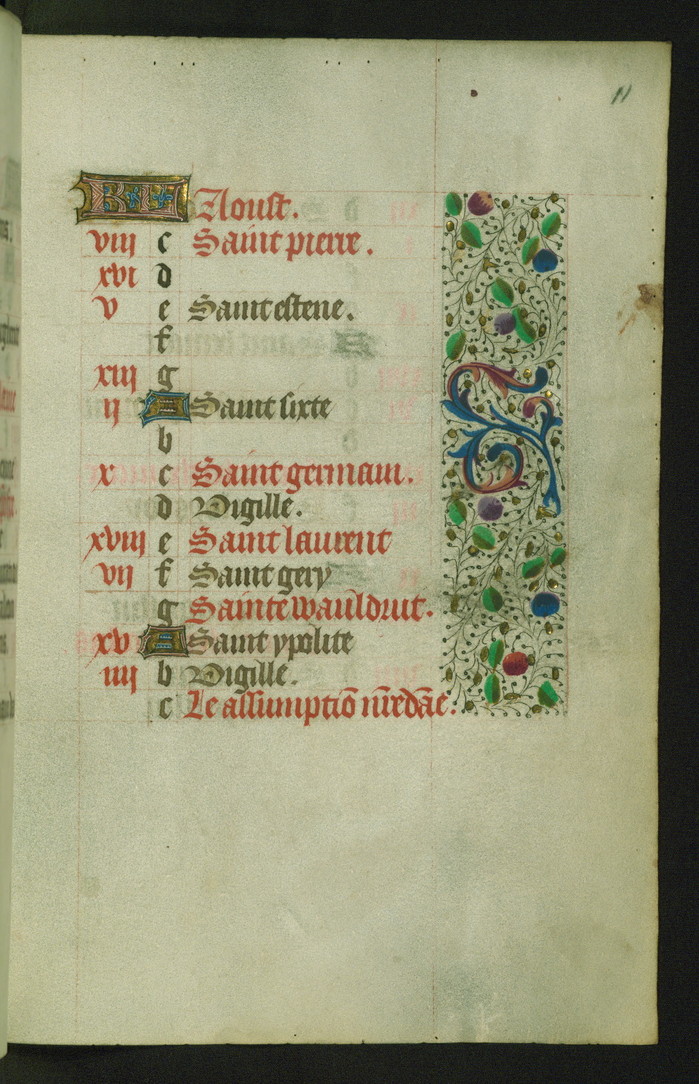
Shifted fully to the Master of the Black Prayerbook, or a follower, gives us Walters Art Museum W.190. It’s another late 15th C Flemish Book of Hours, this one somewhat difficult to localize between Bruges and Liege. It’s been rebound out of order at some point in its life, but having the digitized copy allows us to return it to a more sensible, if not demonstrably original, order.
The calendar is complete “in intent if not in execution”. A scribal error caused April to only have 29 entries, and it appears the feast for April 19 has been omitted. The saints have a very strong Bruges character, often following the unusual saints of that city. There are a few on the wrong dates, and a pair of strange errors. May 23 has “Transfigura[o] d[omi]ni”, where that day is actually the feast of the Translation, which is an unusual feast peculier to Bruges. A stranger error is September 13(see f.9r below), usually the feast of St. Philip, is here listed as “Philippi & Jacobi”. That feast is May 1, and so points to a scribal error rather than a copying error.
(DB Id: 211)
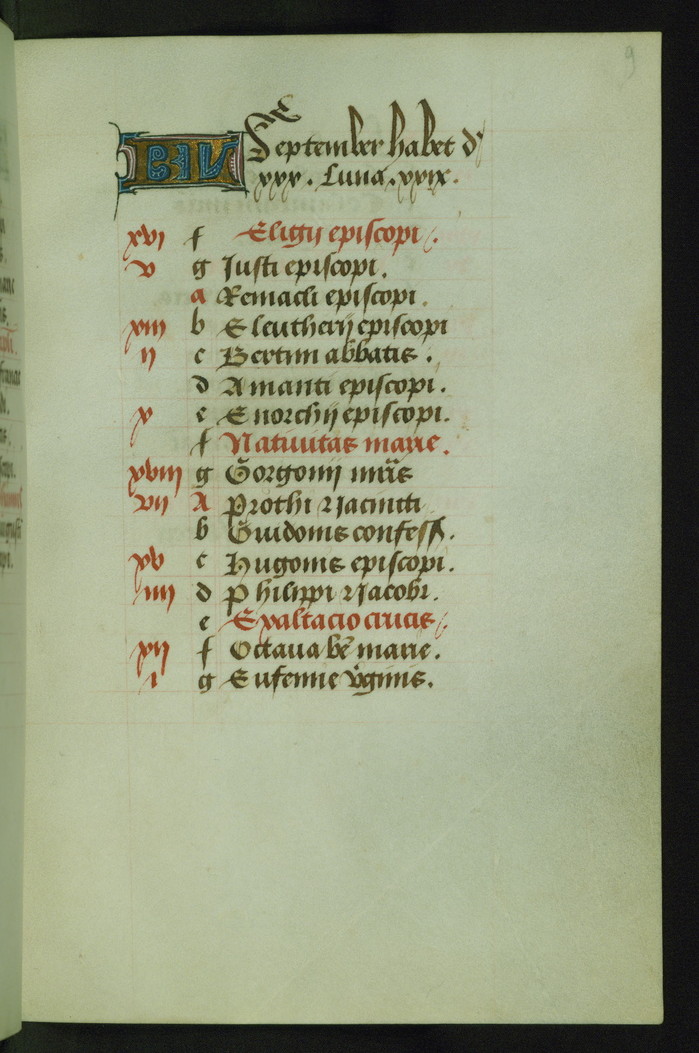
In Walters Art Museum W.189 Willem Vrelant worked with the Master of the Black Prayerbook to create the elaborate color-block foliate borders and full-page grisaille miniatures that fill the book. Even the KL at the top of each month of the calendar are carefully done in grisaille, backgrounded with brown that was hightened with a spray of gold spots.
The calendar entries are in Dutch, though the rest of the book is in Latin. There are only 124 saints in the calendar, mostly the usual ones. There are a few unusual saints, one is St. Brendan, written as “brandaris”, on May 16(see f.5v below). There are actually two Sts. Brendan on that day, and it’s unclear which is meant. Later in that month, May 22, is an unidentified St. Anthonis.
(DB Id: 210) 